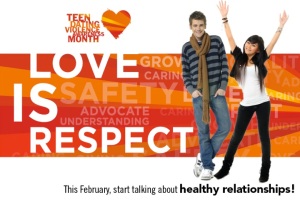 If you ask someone what holiday they associate with the month of February, most will reply “Valentine’s Day.” Fewer of us realize that February also marks Teen Dating Violence Awareness Month. This month aims to educate about the signs and consequences of adolescent dating violence (ADV) and raise awareness about the issue. Teen Dating Violence Awareness Month also provides a great opportunity to do a reality check about some common myths and share lesser-known facts about ADV and the effects it can have on reproductive health. In recognition of the victims of ADV, take some time this Valentine’s Day to read the facts behind these five common misconceptions about ADV and learn more about promoting healthy relationships:
If you ask someone what holiday they associate with the month of February, most will reply “Valentine’s Day.” Fewer of us realize that February also marks Teen Dating Violence Awareness Month. This month aims to educate about the signs and consequences of adolescent dating violence (ADV) and raise awareness about the issue. Teen Dating Violence Awareness Month also provides a great opportunity to do a reality check about some common myths and share lesser-known facts about ADV and the effects it can have on reproductive health. In recognition of the victims of ADV, take some time this Valentine’s Day to read the facts behind these five common misconceptions about ADV and learn more about promoting healthy relationships:
1. Adolescent dating violence doesn’t happen in my community.
According to a 2011 CDC survey, nearly one in ten adolescents reported being the victim of physical dating violence in the past year. The percentage of teens who experience dating violence varies by geographic location and race, but dating violence happens everywhere. Intimate partner violence is also notoriously underreported, so the statistics may underestimate the real size of problem. For example, another study found that up to one in three teens has been the victim of physiological or emotional dating violence.
2. Boys can’t be victims.
 Not true! Male victims get less attention, and many people assume the typical victims of violence are women. But the truth is, boys and girls can both be victims, and they can both be perpetrators. In fact, 9.5% of boys reported being the victims of physical dating violence, compared to 9.3% of girls in 2011. As you can see in the chart, adolescent boys have reported even higher rates of physical violence than girls since 2007.
Not true! Male victims get less attention, and many people assume the typical victims of violence are women. But the truth is, boys and girls can both be victims, and they can both be perpetrators. In fact, 9.5% of boys reported being the victims of physical dating violence, compared to 9.3% of girls in 2011. As you can see in the chart, adolescent boys have reported even higher rates of physical violence than girls since 2007.
3. It’s easy to tell when someone is a victim.
Victim of intimate partner violence don’t always have visible bruises. There are many kinds of abuse – including physical, emotional, and sexual. The National Intimate Partner and Sexual Violence Survey even defines “control of reproductive or sexual health” as a type of violence, which includes: “the refusal by an intimate partner to use a condom. For a woman, it also includes times when a partner tried to get her pregnant when she did not want to become pregnant. For a man, it also includes times when a partner tried to get pregnant when the man did not want her to become pregnant.” Did you know that electronic devices are another way many teens are victimized by their boyfriends or girlfriends? This is an emerging issue to watch, as internet-savvy and mobile-connected teens continue to adopt new technologies.
4. Once a victim leaves the relationship, their problems are over.
Not always. There are many ongoing health consequences associated with ADV. Victims of ADV are more likely to do poorly in school, attempt suicide, and binge drink alcohol. They also are likely to experience violence later in their lives. In fact, more than 1 in 5 women who experience intimate partner violence as adults were victims of ADV as teens. For women in particular, intimate partner violence can have particularly harmful health consequences on their reproductive health, including higher risks for unintended pregnancy, pregnancy complications, or sexually-transmitted diseases.
5. There’s nothing I can do about adolescent dating violence.
Wrong again! One of the easiest things you can do right now is educate yourself. There are great resources to help you understand the signs of adolescent dating violence and learn how to promote health relationships for the teen in your life. Vice President Biden, a longtime advocate of stopping violence against women, has a “1 is 2 Many” initiative if you want to find out how to get more involved. Finally, if you or someone you know is the victim of adolescent dating violence, call the National Teen Dating Abuse Hotline: 1-866-331-9474
Very timely post, Erin! I agree that more information about healthy teen dating should be promoted more in the month of February.